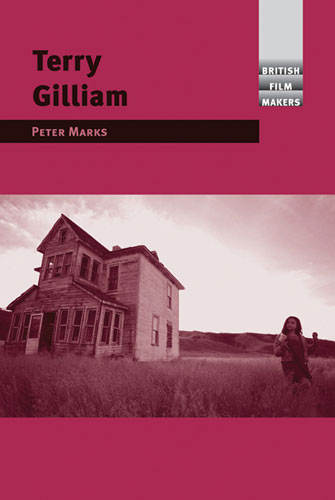| Peter Marks, Terry Gilliam (British Film Makers) Manchester University Press, Manchester UK, 2009 ISBN: 978-0-7190-7032-7 US$84.95 (hb) 274 pp. (Review copy supplied by Manchester University Press) |
 |
Published as part of the Manchester University Press series dedicated to British filmmakers, Peter Marks’ Terry Gilliam opens into a critical debate over national cinema and identity. For the Minnesota-born Gilliam, his classification as a British director is one that, as Marks insists, “has to be argued for rather than merely assumed” (2). Despite moving to the United Kingdom in the 1960s, Terry Gilliam occupies an indeterminate position between the British and American film industries, a status reflected in his filmmaking.
As Marks elaborates within his introduction, the understanding of Gilliam as a British filmmaker is further problematised by the fact that many of the films he’s made since taking out UK citizenship in 1988 (The Fisher King [USA 1991], Twelve Monkeys [USA 1996], Fear and Loathing in Las Vegas [USA 1998]) are, he rightly points out, “his most ‘American’ works” (2).
Reconciling the contested framework of national/cinematic identity by deferring to the director’s films, Marks proceeds with an examination of Terry Gilliam’s artistic tendencies. Foregrounding the aspect of hybridity within Gilliam’s filmography, Marks identifies the repeated divergence from stylistic realism as his defining auteurist trait. Here he states that while,
“…the narrative of a journey to other worlds or metaphysical realms runs through nearly all his films…[w]e need to recognise the multitude of fantastic worlds possible, and their distinctive negotiations with reality. With Gilliam these worlds are not discrete, with the real and the fantastic colliding with and informing each other, adding a crucial interactive dimension” (10)
Marks also draws on this notion of (stylistic and textual) ‘interactivity’ to distinguish Gilliam from the traditional authoritative auteur, highlighting the director’s preference for collaboration. As Gilliam explains, “I’m the filter that lets certain ideas through and stops others. That’s my function; I have an idea of what the film’s supposed to be, but half the things that end up in the film I would never have thought of myself” (7)
What follows is a chronological examination of Terry Gilliam’s career beginning with his television work in the late 1960s. Of specific interest in this early section is the discussion of his involvement in Monty Python’s Flying Circus (1969-74). While Gilliam’s animations indicate a debt to the surrealist movement and the concerns of figures like André Breton, Marks also identifies the emergence of political undertones in his work. In particular, ‘Elephants’, an animation featuring the inflammatory figure of Enoch Powell, indicates for Marks, “something more than a mere stream of consciousness”. He thus surmises that Gilliam’s, “surreal humour can operate as part of a satirical social critique” (20)
While Marks returns to the issue of satire in Gilliam’s later film work (Jabberwocky [UK 1977], Brazil [UK 1985]) he uses his analysis of the animations to return to one of the publication’s key recurring themes: Gilliam’s representation of reality. Referring to Gilliam’s signature cut-up technique, Marks notes how “the cut-up images have a reality of a different order from that of traditionally drawn cartoons, and Gilliam repeatedly toys with the interplay of these levels, or types, of ‘reality’” (23).
The subsequent chapters are similarly grounded in an exploration of Gilliam’s distinct visuals, a style that has occasionally been stymied by other creative figures. Recalling Gilliam’s frustration with director Terry Jones while working (as animator/designer) on Monty Python’s Life of Brian (UK 1979) Marks argues that in terms of his “career as a filmmaker” the film “was a backwards step from Jabberwocky” (58).
These types of creative conflicts together with issues over financing and marketing persist throughout Gilliam’s later projects. Marks relates how the promotion of Time Bandits (UK 1981) in Britain using Gilliam’s Monty Python associations (a strategy the director resisted) “meant that the film did not reach much of its target audience of children and it did poorly at the box office” (79). Likewise, Marks describes how the director’s well publicised clashes with Universal executive Sid Sheinberg over the American release of Brazil “made other American studios wary of him” (103).
In recounting these industrial struggles (particularly for The Adventures of Baron Munchausen [UK/Italy 1988] and The Brothers Grimm [USA/Czech Republic/UK 2005]) the author consolidates a perception of Gilliam as a filmmaker hamstrung by the seemingly irreconcilable nature of his artistic desires to the economic demands of the studio system. And yet Marks remains optimistic about the director’s future. On Tideland (UK/Canada 2005) the most recent of Gilliam’s projects included within the publication – The Imaginarium of Doctor Parnassus (UK/Canada/France 2009) has since been released – he declares that the film,
“…registered Gilliam’s return as a compelling and courageous director still willing to take risks and make complex and demanding films against the trends and norms of an industry dominated and stifled by commercial imperatives” (247)
This industrial context is key to Marks’ study of Gilliam. Rather than approach the director’s filmography through the lens of philosophy or specific cultural theory, Terry Gilliam explores the filmmaker’s work through a balance of textual/technical analysis and a discussion of the various influences that have shaped Gilliam’s career. And while Marks rightfully asserts in the opening line of the publication that, “An illuminating book could be written on the films Terry Gilliam has not made” (1), this is a detailed and engaging place to start.
